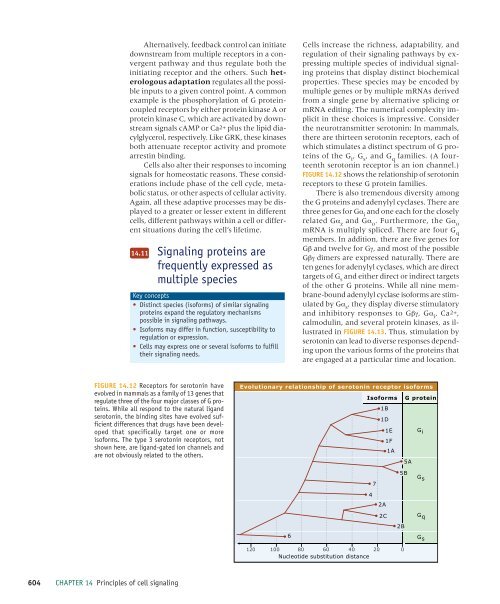Principles of cell signaling - UT Southwestern
Principles of cell signaling - UT Southwestern
Principles of cell signaling - UT Southwestern
Create successful ePaper yourself
Turn your PDF publications into a flip-book with our unique Google optimized e-Paper software.
39057_ch14_<strong>cell</strong>bio.qxd 8/28/06 5:11 PM Page 604<br />
Alternatively, feedback control can initiate<br />
downstream from multiple receptors in a convergent<br />
pathway and thus regulate both the<br />
initiating receptor and the others. Such heterologous<br />
adaptation regulates all the possible<br />
inputs to a given control point. A common<br />
example is the phosphorylation <strong>of</strong> G proteincoupled<br />
receptors by either protein kinase A or<br />
protein kinase C, which are activated by downstream<br />
signals cAMP or Ca2+ plus the lipid diacylglycerol,<br />
respectively. Like GRK, these kinases<br />
both attenuate receptor activity and promote<br />
arrestin binding.<br />
Cells also alter their responses to incoming<br />
signals for homeostatic reasons. These considerations<br />
include phase <strong>of</strong> the <strong>cell</strong> cycle, metabolic<br />
status, or other aspects <strong>of</strong> <strong>cell</strong>ular activity.<br />
Again, all these adaptive processes may be displayed<br />
to a greater or lesser extent in different<br />
<strong>cell</strong>s, different pathways within a <strong>cell</strong> or different<br />
situations during the <strong>cell</strong>’s lifetime.<br />
14.11<br />
Signaling proteins are<br />
frequently expressed as<br />
multiple species<br />
Key concepts<br />
• Distinct species (is<strong>of</strong>orms) <strong>of</strong> similar <strong>signaling</strong><br />
proteins expand the regulatory mechanisms<br />
possible in <strong>signaling</strong> pathways.<br />
• Is<strong>of</strong>orms may differ in function, susceptibility to<br />
regulation or expression.<br />
• Cells may express one or several is<strong>of</strong>orms to fulfill<br />
their <strong>signaling</strong> needs.<br />
Cells increase the richness, adaptability, and<br />
regulation <strong>of</strong> their <strong>signaling</strong> pathways by expressing<br />
multiple species <strong>of</strong> individual <strong>signaling</strong><br />
proteins that display distinct biochemical<br />
properties. These species may be encoded by<br />
multiple genes or by multiple mRNAs derived<br />
from a single gene by alternative splicing or<br />
mRNA editing. The numerical complexity implicit<br />
in these choices is impressive. Consider<br />
the neurotransmitter serotonin: In mammals,<br />
there are thirteen serotonin receptors, each <strong>of</strong><br />
which stimulates a distinct spectrum <strong>of</strong> G proteins<br />
<strong>of</strong> the G i<br />
, G s<br />
, and G q<br />
families. (A fourteenth<br />
serotonin receptor is an ion channel.)<br />
FIGURE 14.12 shows the relationship <strong>of</strong> serotonin<br />
receptors to these G protein families.<br />
There is also tremendous diversity among<br />
the G proteins and adenylyl cyclases. There are<br />
three genes for Gα i<br />
and one each for the closely<br />
related Gα z<br />
and Gα o<br />
. Furthermore, the Gα o<br />
mRNA is multiply spliced. There are four G q<br />
members. In addition, there are five genes for<br />
Gβ and twelve for Gγ, and most <strong>of</strong> the possible<br />
Gβγ dimers are expressed naturally. There are<br />
ten genes for adenylyl cyclases, which are direct<br />
targets <strong>of</strong> G s<br />
and either direct or indirect targets<br />
<strong>of</strong> the other G proteins. While all nine membrane-bound<br />
adenylyl cyclase is<strong>of</strong>orms are stimulated<br />
by Gα s<br />
, they display diverse stimulatory<br />
and inhibitory responses to Gβγ, Gα i<br />
, Ca2+,<br />
calmodulin, and several protein kinases, as illustrated<br />
in FIGURE 14.13. Thus, stimulation by<br />
serotonin can lead to diverse responses depending<br />
upon the various forms <strong>of</strong> the proteins that<br />
are engaged at a particular time and location.<br />
FIGURE 14.12 Receptors for serotonin have<br />
evolved in mammals as a family <strong>of</strong> 13 genes that<br />
regulate three <strong>of</strong> the four major classes <strong>of</strong> G proteins.<br />
While all respond to the natural ligand<br />
serotonin, the binding sites have evolved sufficient<br />
differences that drugs have been developed<br />
that specifically target one or more<br />
is<strong>of</strong>orms. The type 3 serotonin receptors, not<br />
shown here, are ligand-gated ion channels and<br />
are not obviously related to the others.<br />
Evolutionary relationship <strong>of</strong> serotonin receptor is<strong>of</strong>orms<br />
Is<strong>of</strong>orms G protein<br />
1B<br />
1D<br />
1E G i<br />
1F<br />
1A<br />
5A<br />
7<br />
5B<br />
G s<br />
4<br />
2A<br />
2C<br />
G q<br />
6<br />
2B<br />
G s<br />
120 100 80 60 40 20 0<br />
Nucleotide substitution distance<br />
604 CHAPTER 14 <strong>Principles</strong> <strong>of</strong> <strong>cell</strong> <strong>signaling</strong>
















